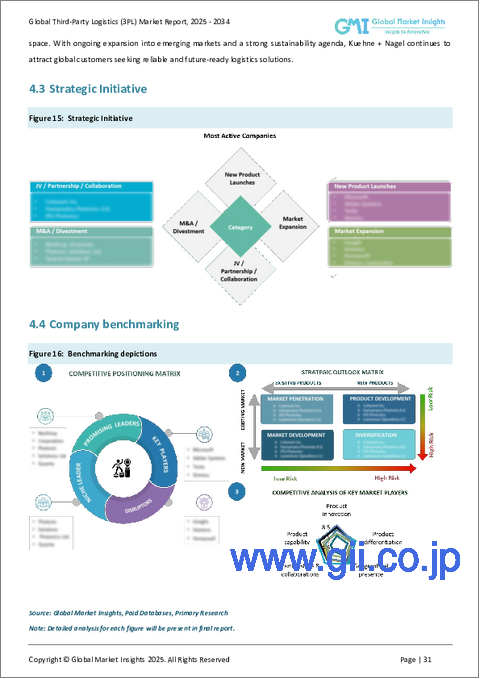|
|
市場調査レポート
商品コード
1685143
サードパーティロジスティクス市場の機会、成長促進要因、産業動向分析、2025年~2034年の予測Third-Party Logistics (3PL) Market Opportunity, Growth Drivers, Industry Trend Analysis, and Forecast 2025 - 2034 |
||||||
カスタマイズ可能
|
|||||||
| サードパーティロジスティクス市場の機会、成長促進要因、産業動向分析、2025年~2034年の予測 |
|
出版日: 2025年01月07日
発行: Global Market Insights Inc.
ページ情報: 英文 180 Pages
納期: 2~3営業日
|
全表示
- 概要
- 目次
世界のサードパーティロジスティクス市場は2024年に1兆5,000億米ドルと評価され、2025年から2034年にかけてCAGR 10.1%で拡大すると予測されています。
この急成長は、世界中の企業が注文量の増加と、より迅速で信頼性の高いロジスティクス・ソリューションの必要性に直面しているため、小売およびeコマース分野での需要の増加が原動力となっています。オンライン・ショッピングの急増により競争が激化し、企業は複雑なサプライ・チェーンを管理しながら効率性を高める必要に迫られています。その結果、より多くの企業が、消費者の需要の変動や小売動向の変化に対応できる拡張性のあるロジスティクス・ソリューションを求めて、3PLプロバイダーを利用するようになっています。

eコマースの活況に加え、世界なサプライチェーンと国境を越えた貿易の拡大が、高度なロジスティクス管理の必要性をさらに高めています。企業は、物流ネットワークの合理化と業務効率の改善を常に迫られており、アウトソーシングは戦略的な一手となっています。ラスト・マイル・デリバリー、倉庫管理、フルフィルメント・センターがますます重視される中、3PLプロバイダーはシームレスなロジスティクス・オペレーションを確保する上で不可欠なパートナーです。サードパーティの専門知識を活用することで、企業は諸経費を削減し、配送スケジュールを改善し、在庫管理を最適化することができます。
| 市場範囲 | |
|---|---|
| 開始年 | 2024 |
| 予測年 | 2025-2034 |
| 開始価値 | 1兆5,000億米ドル |
| 予測金額 | 4兆ドル |
| CAGR | 10.1% |
技術の進歩も3PL市場の拡大に極めて重要な役割を果たしています。データ分析の統合により、物流業者は需要の変動をより正確に予測し、ルートを最適化し、業務の透明性を高めることができます。リアルタイムの追跡システム、自動化、人工知能を駆使したソリューションは、サプライチェーン・マネジメントを変革し、ロジスティクス業務の応答性と適応性を高めています。企業が顧客満足度の向上に努める中、こうした最先端技術の採用により、3PLサービスはより魅力的なものとなり、現代のサプライチェーン戦略にとって不可欠なものとなっています。
同市場は、航空、海上、鉄道・道路など、輸送手段別にセグメント化されています。海上輸送分野は2024年に市場シェアの35%を占め、2034年までに1兆5,000億米ドルを生み出すと予想されています。世界貿易が拡大し続ける中、海上輸送はその費用対効果と大量の貨物を扱う能力から、長距離輸送の手段として依然として好まれています。海運は、特に原材料や製造品の大量輸送において、国際貿易の重要な要素です。世界化が進み、効率的なサプライチェーン・オペレーションへのニーズが高まる中、企業はシームレスでコスト効率の高い貿易を実現するため、海上ロジスティクスに大きく依存しています。
サードパーティロジスティクス市場は用途別にもセグメント化されており、2024年の市場シェアは小売セクターが31%を占めています。サプライチェーンが複雑化する中、小売業者は3PLサービスを活用し、国内外における流通の最適化を図っています。より迅速で確実な配送に対する消費者の期待が高まる中、企業は倉庫管理からラストワンマイルの配送まで、エンドツーエンドの物流ソリューションを提供する3PLプロバイダーと提携するようになっています。ロジスティクス業務をアウトソーシングすることで、小売企業はシームレスなサプライチェーンの実行を確保しながら、中核となる事業活動に集中することができます。
米国のサードパーティロジスティクス市場は、2024年に市場シェアの80%を占める。コスト削減とサプライチェーンの最適化が重視されるようになったことで、企業はロジスティクス業務のアウトソーシングを進めています。さまざまな業種の企業が、業務の合理化、効率性の向上、ロジスティクスの専門知識の活用のために3PLプロバイダーと提携しています。eコマースの継続的拡大、高度なロジスティクス・ソリューション、デジタルトランスフォーメーションに向けた強力な推進力により、米国のサードパーティロジスティクス・サービスに対する需要は引き続き堅調に推移し、市場の上昇基調が強まると予想されます。
目次
第1章 調査手法と調査範囲
- 調査デザイン
- 調査アプローチ
- データ収集方法
- 基本推定と計算
- 基準年の算出
- 市場推計の主要動向
- 予測モデル
- 1次調査と検証
- 1次情報
- データマイニングソース
- 市場スコープと定義
第2章 エグゼクティブサマリー
第3章 業界洞察
- エコシステム分析
- 3PLプロバイダー
- 荷主
- 輸送業者
- 倉庫・配送センター
- テクノロジープロバイダー
- 最終顧客
- サプライヤーの状況
- 利益率分析
- 技術とイノベーションの展望
- 特許分析
- 主要ニュース&イニシアチブ
- 規制状況
- 親子市場分析
- 影響要因
- 促進要因
- 小売・eコマースの急拡大
- 自動化、AI、データ分析の進歩
- 貿易の世界化と国境を越えた出荷
- 市場の成長を促す政府の取り組み
- 業界の潜在的リスク&課題
- 物流管理の欠如
- 国境を越えた輸送に伴うリスク
- 促進要因
- 成長可能性分析
- ポーター分析
- PESTEL分析
第4章 競合情勢
- イントロダクション
- 企業シェア分析
- 競合のポジショニング・マトリックス
- 戦略展望マトリックス
第5章 市場推計・予測:ソリューション別、2021年~2034年
- 主要動向
- 専用輸送契約(DCC)
- 専用輸送管理(DTM)
- 国際輸送管理(ITM)
- 倉庫管理・配送
- 物流ソフトウェア
第6章 市場推計・予測:モード別、2021年~2034年
- 主要動向
- 航空
- 海上
- 鉄道・道路
第7章 市場推計・予測:用途別、2021年~2034年
- 主要動向
- 飲食品
- ヘルスケア
- 小売
- 自動車
- 製造業
- その他
第8章 市場推計・予測:地域別、2021年~2034年
- 主要動向
- 北米
- 米国
- カナダ
- メキシコ
- 欧州
- 英国
- ドイツ
- フランス
- イタリア
- ロシア
- スペイン
- オランダ
- スイス
- アジア太平洋
- 中国
- インド
- 日本
- オーストラリア
- 韓国
- インドネシア
- 南米
- ブラジル
- アルゼンチン
- コロンビア
- チリ
- 中東・アフリカ
- UAE
- 南アフリカ
- サウジアラビア
- トルコ
第9章 企業プロファイル
- AmeriCold Logistics
- BDP International
- Burris Logistics
- C.H. Robinson
- DB Schenker
- DHL
- DSV
- Echo
- Expeditors
- FedEx
- GEODIS
- J. B. Hunt
- Kintetsu
- Kuehne+Nagel
- Nippon
- Penske Logistics
- SinoTrans
- Total Quality Logistics
- UPS
- XPO
The Global Third-Party Logistics Market was valued at USD 1.5 trillion in 2024 and is projected to expand at a CAGR of 10.1% between 2025 and 2034. This rapid growth is driven by the increasing demand in retail and e-commerce sectors, as businesses worldwide face rising order volumes and the need for faster, more reliable logistics solutions. The surge in online shopping has intensified competition, pushing companies to enhance efficiency while managing complex supply chains. As a result, more businesses are turning to 3PL providers for scalable logistics solutions that can adapt to fluctuating consumer demands and evolving retail trends.

Beyond the booming e-commerce landscape, the expansion of global supply chains and cross-border trade is further fueling the need for sophisticated logistics management. Companies are under constant pressure to streamline their distribution networks and improve operational efficiency, making outsourcing a strategic move. With a growing emphasis on last-mile delivery, warehousing, and fulfillment centers, 3PL providers are essential partners in ensuring seamless logistics operations. The ability to leverage third-party expertise helps businesses reduce overhead costs, improve delivery timelines, and optimize inventory management.
| Market Scope | |
|---|---|
| Start Year | 2024 |
| Forecast Year | 2025-2034 |
| Start Value | $1.5 Trillion |
| Forecast Value | $4 Trillion |
| CAGR | 10.1% |
Technological advancements are also playing a pivotal role in the expansion of the 3PL market. The integration of data analytics enables logistics providers to predict demand fluctuations more accurately, optimize routes, and enhance operational transparency. Real-time tracking systems, automation, and artificial intelligence-driven solutions are transforming supply chain management, making logistics operations more responsive and adaptable. As businesses strive to enhance customer satisfaction, the adoption of these cutting-edge technologies is making 3PL services more attractive and indispensable for modern supply chain strategies.
The market is segmented by mode of transport, including air, sea, and rail & road. The sea transportation segment accounted for 35% of the market share in 2024 and is expected to generate USD 1.5 trillion by 2034. As global trade continues to expand, sea freight remains the preferred method for long-distance transportation due to its cost-effectiveness and ability to handle large cargo volumes. Shipping is a crucial component of international trade, particularly for bulk shipments of raw materials and manufactured goods. With increasing globalization and the growing need for efficient supply chain operations, businesses are heavily relying on maritime logistics for seamless and cost-efficient trade.
The third-party logistics market is also segmented by application, with the retail sector holding 31% of the market share in 2024. As supply chains grow in complexity, retailers are leveraging 3PL services to optimize both domestic and international distribution. The rising consumer expectations for faster and more reliable deliveries are prompting businesses to partner with 3PL providers that offer end-to-end logistics solutions, from warehousing to last-mile delivery. By outsourcing logistics operations, retailers can focus on core business activities while ensuring seamless supply chain execution.
The U.S. third-party logistics market captured 80% of the market share in 2024. The increasing emphasis on cost reduction and supply chain optimization is driving businesses to outsource their logistics functions. Companies across industries are partnering with 3PL providers to streamline operations, enhance efficiency, and leverage logistics expertise. With the continuous expansion of e-commerce, advanced logistics solutions, and a strong push toward digital transformation, the demand for third-party logistics services in the U.S. is expected to remain strong, reinforcing the market's upward trajectory.
Table of Contents
Chapter 1 Methodology & Scope
- 1.1 Research design
- 1.1.1 Research approach
- 1.1.2 Data collection methods
- 1.2 Base estimates & calculations
- 1.2.1 Base year calculation
- 1.2.2 Key trends for market estimation
- 1.3 Forecast model
- 1.4 Primary research and validation
- 1.4.1 Primary sources
- 1.4.2 Data mining sources
- 1.5 Market scope & definition
Chapter 2 Executive Summary
- 2.1 Industry 3600 synopsis, 2021 - 2034
Chapter 3 Industry Insights
- 3.1 Industry ecosystem analysis
- 3.1.1 3PL providers
- 3.1.2 Shippers
- 3.1.3 Carriers
- 3.1.4 Warehouses and distribution centers
- 3.1.5 Technology providers
- 3.1.6 End customers
- 3.2 Supplier landscape
- 3.3 Profit margin analysis
- 3.4 Technology & innovation landscape
- 3.5 Patent analysis
- 3.6 Key news & initiatives
- 3.7 Regulatory landscape
- 3.8 Parent and child market analysis
- 3.9 Impact forces
- 3.9.1 Growth drivers
- 3.9.1.1 The rapid expansion of retail and e-commerce industry
- 3.9.1.2 Advancements in automation, AI, and data analytics
- 3.9.1.3 The globalization of trade and cross-border shipments
- 3.9.1.4 Government initiatives encouraging market growth
- 3.9.2 Industry pitfalls & challenges
- 3.9.2.1 Lack of logistics control
- 3.9.2.2 Risks associated with cross-border transportation
- 3.9.1 Growth drivers
- 3.10 Growth potential analysis
- 3.11 Porter’s analysis
- 3.12 PESTEL analysis
Chapter 4 Competitive Landscape, 2024
- 4.1 Introduction
- 4.2 Company market share analysis
- 4.3 Competitive positioning matrix
- 4.4 Strategic outlook matrix
Chapter 5 Market Estimates & Forecast, By Solution, 2021 - 2034 ($Bn)
- 5.1 Key trends
- 5.2 Dedicated Contract Carriage (DCC)
- 5.3 Dedicated Transportation Management (DTM)
- 5.4 International Transportation Management (ITM)
- 5.5 Warehousing & distribution
- 5.6 Logistics software
Chapter 6 Market Estimates & Forecast, By Mode, 2021 - 2034 ($Bn)
- 6.1 Key trends
- 6.2 Air
- 6.3 Sea
- 6.4 Rail & Road
Chapter 7 Market Estimates & Forecast, By Application, 2021 - 2034 ($Bn)
- 7.1 Key trends
- 7.2 Food & beverages
- 7.3 Healthcare
- 7.4 Retail
- 7.5 Automotive
- 7.6 Manufacturing
- 7.7 Others
Chapter 8 Market Estimates & Forecast, By Region, 2021 - 2034 ($Bn)
- 8.1 Key trends
- 8.2 North America
- 8.2.1 U.S.
- 8.2.2 Canada
- 8.2.3 Mexico
- 8.3 Europe
- 8.3.1 UK
- 8.3.2 Germany
- 8.3.3 France
- 8.3.4 Italy
- 8.3.5 Russia
- 8.3.6 Spain
- 8.3.7 Netherlands
- 8.3.8 Switzerland
- 8.4 Asia Pacific
- 8.4.1 China
- 8.4.2 India
- 8.4.3 Japan
- 8.4.4 Australia
- 8.4.5 South Korea
- 8.4.6 Indonesia
- 8.5 South America
- 8.5.1 Brazil
- 8.5.2 Argentina
- 8.5.3 Colombia
- 8.5.4 Chile
- 8.6 MEA
- 8.6.1 UAE
- 8.6.2 South Africa
- 8.6.3 Saudi Arabia
- 8.6.4 Turkey
Chapter 9 Company Profiles
- 9.1 AmeriCold Logistics
- 9.2 BDP International
- 9.3 Burris Logistics
- 9.4 C.H. Robinson
- 9.5 DB Schenker
- 9.6 DHL
- 9.7 DSV
- 9.8 Echo
- 9.9 Expeditors
- 9.10 FedEx
- 9.11 GEODIS
- 9.12 J. B. Hunt
- 9.13 Kintetsu
- 9.14 Kuehne + Nagel
- 9.15 Nippon
- 9.16 Penske Logistics
- 9.17 SinoTrans
- 9.18 Total Quality Logistics
- 9.19 UPS
- 9.20 XPO





